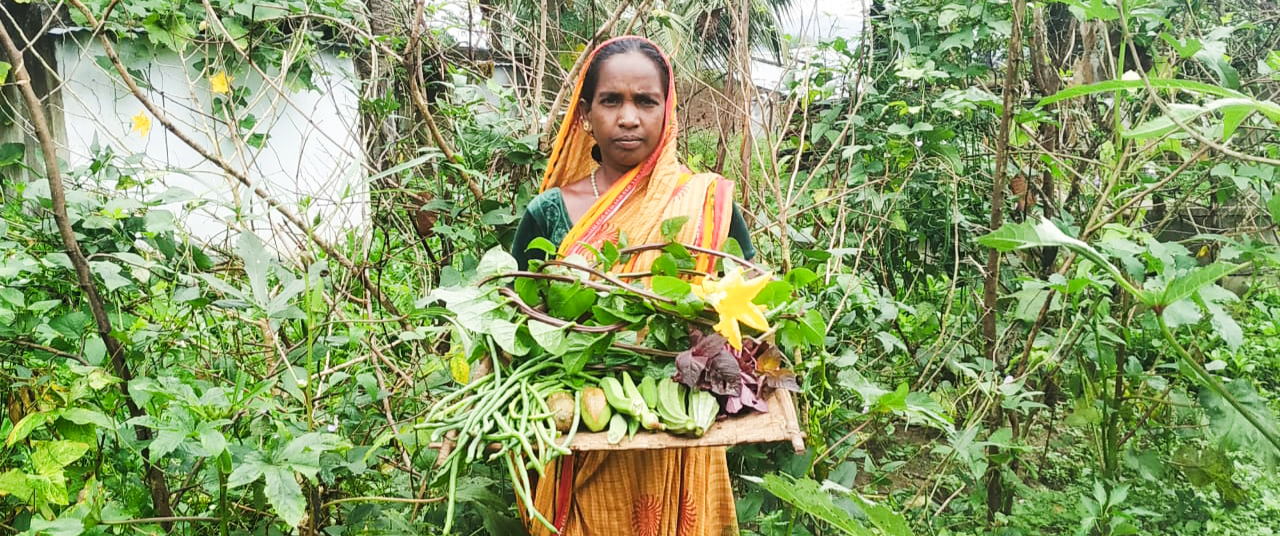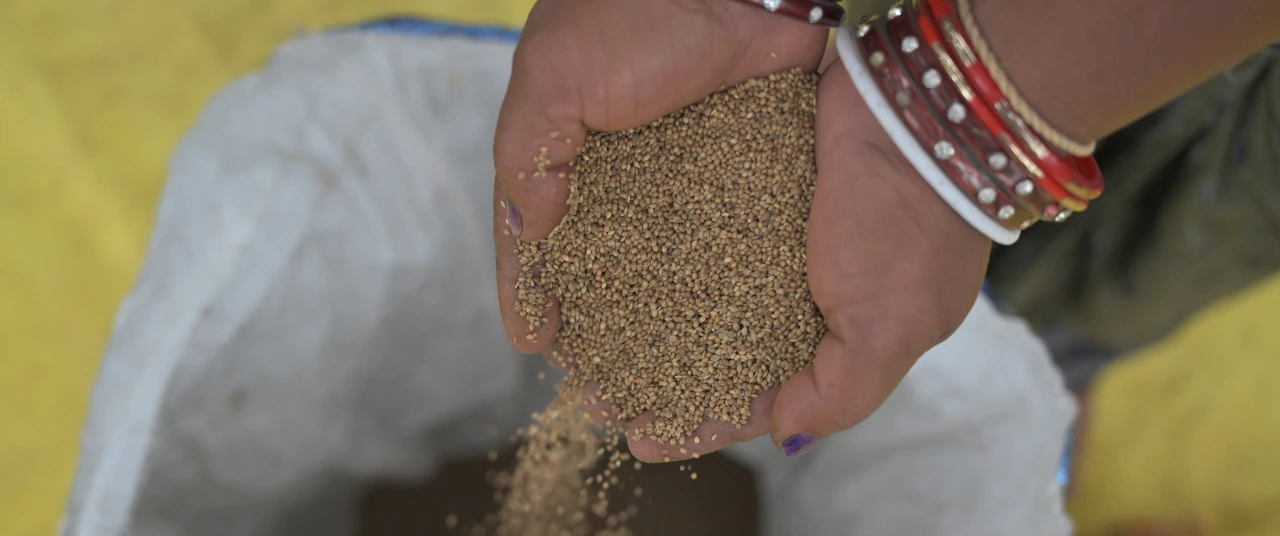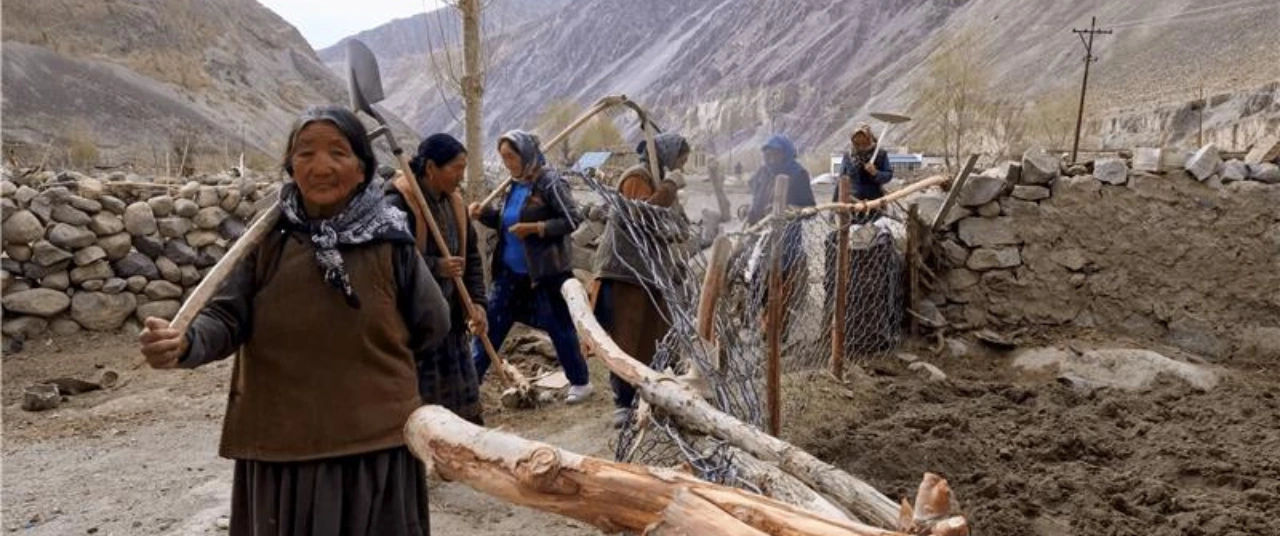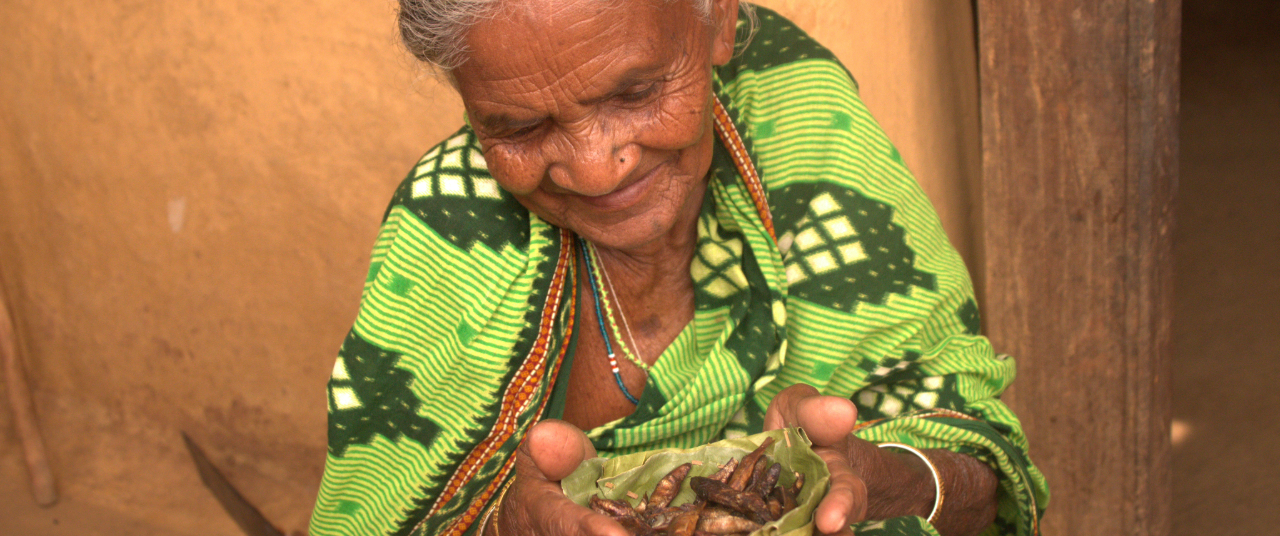Through her tubers, pulses and millets, Sabitri Pangi is bringing diversity back to her village’s meals






In the early morning light, 43-year-old Sabitri Pangi can be found in her backyard, tending to her kitchen garden. But this patch of green is like no other. "We grow only traditional crops," explains Pangi. Among a variety of vegetables, tubers and greens, Pangi sows heirloom seeds of pumpkin, okra, and bitter gourd in the soil. "These seeds are precious gifts from our forefathers, passed down through the generations. Losing them would mean losing our identity," she reflects.
Pangi is a resident of Purulubandha, a hilltop village in the Chitrakonda block of Malkangiri district in Southern Odisha, close to the state’s border with Andhra Pradesh. The village comprises only 42 households–the majority of them belonging to the Kotia tribe–including Pangi’s.
During her childhood, Pangi worked alongside her parents on their farm in the nearby Polaspadar village, where the family practiced mixed farming and grew a variety of crops. She recalls that in those days, farmers relied solely on traditional seeds, which yielded abundant harvests. "We used to harvest crop by crop. The crops were resilient—they could withstand delayed rainfall and excessive heat. Besides, the produce was tasty and rich in nutrition," she reminisces.
.webp)
The selection and saving of seeds that come from crops with the most flavour and nutrition is a technique that has long served farmers across geographies. They also saved those seeds which had the ability to resist pests and diseases; gradually and gently, each generation of crop became stronger, tastier, more diverse. So familiar were these plants to the local regions and their climatic moods, that their seeds learnt to grow into crops that could withstand unpredictable rains and extreme temperatures.
I firmly believe that by restoring the glory of our traditional seeds, we can revive our agricultural heritage.
But by the time Pangi turned 20, she noticed a shift in farming practices. Many farmers in her village switched to mono-cropping. Hybrid varieties of paddy, maize, potato, and cotton became the dominant crops, pushing traditional varieties into the shadows. The seeds of these crops are bred to ensure uniformity and specific traits like abundant harvest each season–definitely beneficial to farmers. And initially, the yields were high, but farmers soon realised that these commercial crops struggled to survive in extreme climatic conditions.
Also read: How women in this tiny Naga village are safeguarding local seeds
Moreover, Pangi noted that farmers’ expenses were driven up year on year by the cost of these hybrid seeds as well as chemical inputs. Hybrid seeds need chemical fertilisers, because high output demands a consistent supply of nutrients, which these crops may not get from soil in a concentrated manner.
In this process, the community was losing traditional crops–and consequently, many many age-old recipes tied to them were also being forgotten. It was this farming crisis that inspired Pangi to conserve traditional seeds. "I firmly believe that by restoring the glory of our traditional seeds, we can revive our agricultural heritage," she asserts.
Reviving what is now rare
Today, Pangi’s two-acre farm stands as a vibrant repository of agrobiodiversity, thriving with traditional crops. She has preserved nine varieties of wild tubers, five varieties of heirloom vegetables, seven varieties of pulses, and several local varieties of paddy, millets, and oilseeds. Committed to seed conservation, she often shares and exchanges traditional seeds with farmers in her village and neighbouring communities.

Pangi cultivates several varieties of traditional tubers, including Langal Kanda (greater yam), Ful Sarenda (five leaf yam), Kasa Kanda (Indian three-leaved yam), Pita Kanda (bitter yam), Pit Kanda (cinnamon vine), and Cherang kanda (wallich's wild yam). There’s a reason why she prioritises maintaining this diversity. "These tubers are hardy crops—they grow with minimal water and resist pests. Rice may fill our stomachs, but tubers give us the strength to work longer on our farms. They provide more energy and nourishment," explains Pangi.
Also read: The tribal seed guardians of Dindori
In addition to tubers, Pangi’s farm is home to a diverse range of traditional vegetables, including Satapatri Bhendi (okra), Cheli Ludki (clove beans), Bada Kumuda (big pumpkin), Chota Kumuda (small pumpkin), and Chota Karla (bitter gourd). Pangi believes these traditional varieties surpass hybrid ones in many ways. For example, Satapatri Bhendi begins flowering after producing just seven leaves. Similarly, Chota Kumuda and Chota Karla grow faster and require less water and manure. "These varieties are well-suited to our climate and soil. They also attract fewer pests and diseases," explains Pangi.
Traditionally, the Kotia tribe has sustained itself through agriculture and selling wild produce from neighbouring forests. As farmers, the members of this tribe have always cultivated a wide variety of pulses. However, many of these local pulse varieties have become rare, surviving only with a few farmers in remote villages. So, to begin with, Pangi visited neighboring villages to collect various pulse varieties. She exchanged her own seeds with other farmers, bringing new varieties back to her farm. Today, Pangi has successfully conserved several traditional pulses, including Jailo (lima beans), Jhudunga (cowpea), Ranjh Semi (broad beans), Matia Buta Semi (brown kidney beans), Muga (green gram), Misani Biri (black gram), and Kala Kolatha (horse gram).
“These pulses are vital for the community’s health, as they have high nutritional value. They also improve soil fertility through nitrogen fixation,” explains Susanta Sekhar Choudhury, Program Manager-Seed System at Watershed Support Services and Activities Network (WASSAN), Bhubaneswar, a non-profit that works in the rainfed area for bringing prosperity and ecological security to marginalised communities.
Also read: Can nitrogen-fixing plants replace synthetic fertilisers?
Besides, the crop residues of these pulses are also used as fodder for livestock. When fodder is scarce, particularly in summer, Pangi says, “We feed crop residues to our goats and sheep. It helps maintain the health of our animals.” Pangi also grows local varieties of oil seed like Alasi (Niger), along with cereals such as Mahul Kuchi Dhana (Paddy), Kasam Jhopa Suan (Little Millet), and the Mami, Bati and Sili varieties of finger millet.
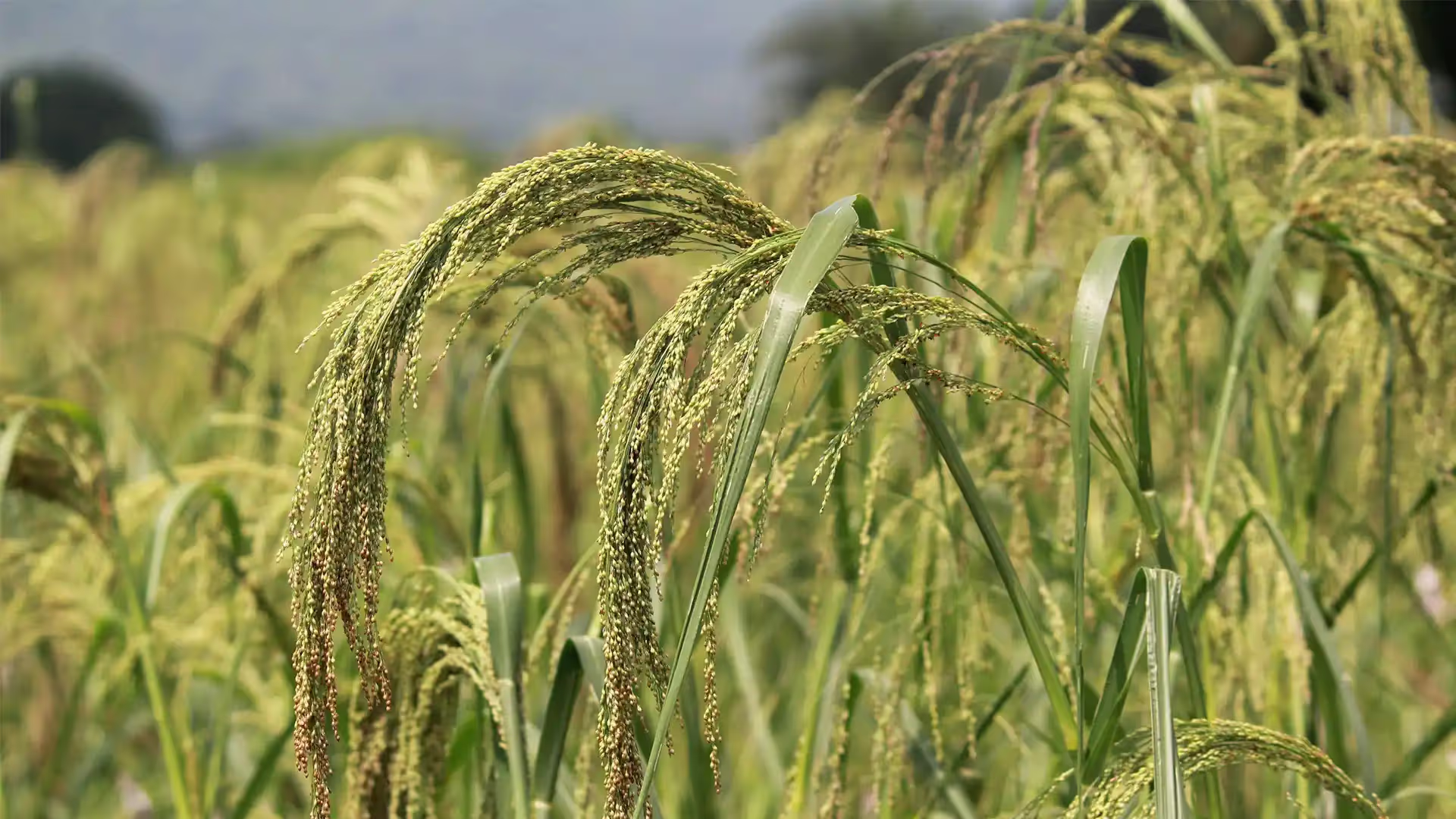
Gopinath Pangi (48), Sabitri's husband, vouches for his wife’s work with conviction. "My wife has worked tirelessly to revive our traditional seeds. It took her nearly 10 years to collect, exchange, and conserve many traditional varieties that had become rare, known to only a few farmers. Through her efforts, she has helped us reconnect with our roots."
Casting a long shadow
Inspired by the diversity and vibrancy of Pangi’s farm, around 20 women from Purulubandha and nearby villages have transitioned from monocropping to multi-cropping systems using organic methods. "Initially, many women were not convinced," Pangi recalls. "So, I invited them to visit my farm. When they saw the fertile soil and healthy crops, their confidence grew. They realised that our age-old farming practices and traditional seeds can yield a good harvest."
Earlier, rice was our staple food. But after growing multiple traditional crops and vegetables, our meals have become more diverse. Now, our food plate is more colorful.
Mukta Pangi, a 37-year-old resident of Purulubandha, happily shares her experience with traditional crops. "Earlier, rice was our staple food. But after growing multiple traditional crops and vegetables, our meals have become more diverse. Now, our food plate is more colorful," she says with a smile. Similarly, Kantamal Pangi, another tribal woman in her 40s, has pledged to preserve heirloom seeds. "Growing traditional crops rejuvenates soil fertility. We use only farmyard manure, eliminating the need for expensive chemical fertilisers or hybrid seeds," she explains.
According to Choudhury, these traditional crops and mixed farming practices are deeply rooted in the ancient wisdom of tribal communities. Not only do they support local diets, but these crops also contribute to the region’s ecological balance by preserving genetic diversity and enhancing farmers' resilience to climate change.
Preserving culinary heritage
Tribal women farmers like Pangi, Mukta, and Kantamal are relentlessly conserving local agrobiodiversity and through this, they’re also promoting traditional culinary heritage. "Crops, food, and culture are deeply interconnected in our tribal community," explains Pangi. She adds, "When a crop variety disappears, its traditional recipes vanish with it. By preserving our traditional crops, we ensure that our culinary heritage and culture continue to thrive. Our traditional recipes celebrate the unique flavours of our ancient crops."
Mukta says with pride, “Each recipe is unique as they are carefully crafted to honour our ancestral knowledge. These recipes have been passed down from one generation to the next through stories, histories, legends and myths. It connects us to our ancestors and Mother Earth.” Some of the traditional recipes of Kotia tribe include Cheli Ludki Sag (prepared from clove beans), Kumuda Je Dangarani (prepared from rice bean; the full recipe can be found at the end of this article), Kolatha Je Munika Sag (prepared from Horsegram), Ranj Semi Sag (prepared from lima bean), Bhalia Anda (prepared from custard apple), and Mandru (prepared from finger millet).

However, as the younger generations of these tribal communities are fond of urban cuisine–as part of an aspirational lifestyle– the knowledge associated with traditional food culture is eroding away. Importantly, it should also be noted that over the years, the Public Distribution System (PDS) has changed food preferences such that rice has become a staple diet in rural areas.
To safeguard the state’s tribal food heritage, the Odisha government has launched flagship programs like the Shree Anna Abhiyan (SAA), which is reviving millet cultivation and reintroducing millets to local diets across all 30 districts of the state. Additionally, the Department of Agriculture and Farmers’ Empowerment (DA&FE) is working to restore the diverse but forgotten food and culinary heritage of tribal communities in Malkangiri and Nuapada district by documentation and promotion.
"Odisha has been a pioneer in promoting agrobiodiversity," says Dr. Arabinda Kumar Padhee, Principal Secretary, DA&FE. He notes that the state has registered over 700 farmer’s varieties with the Protection of Plant Varieties and Farmers’ Rights Authority. Additionally, landraces from more than 500 remote villages have been mapped and documented. Amid the looming threat of climate change, it is imperative to give due recognition and agricultural policy support to these neglected crops, he underlines.
Kumuda Je Dangarani recipe
Kumuda Je Dangarani is a traditional recipe of the Kotia tribe, one of many.
To cook this delicacy, first wash the rice beans thoroughly with water. Once washed, soak the rice beans for at least two hours.
After two hours, boil the beans with a pinch of salt for 15-20 minutes on a medium flame.
Cut your pumpkin into cubes. Add this pumpkin and turmeric powder to the rice bean and cook for another 15-20 minutes. Add chili powder to the cooked rice bean and pumpkin. Add salt and garlic into the mix. Cook until the gravy thickens. Serve hot with rice or roti.
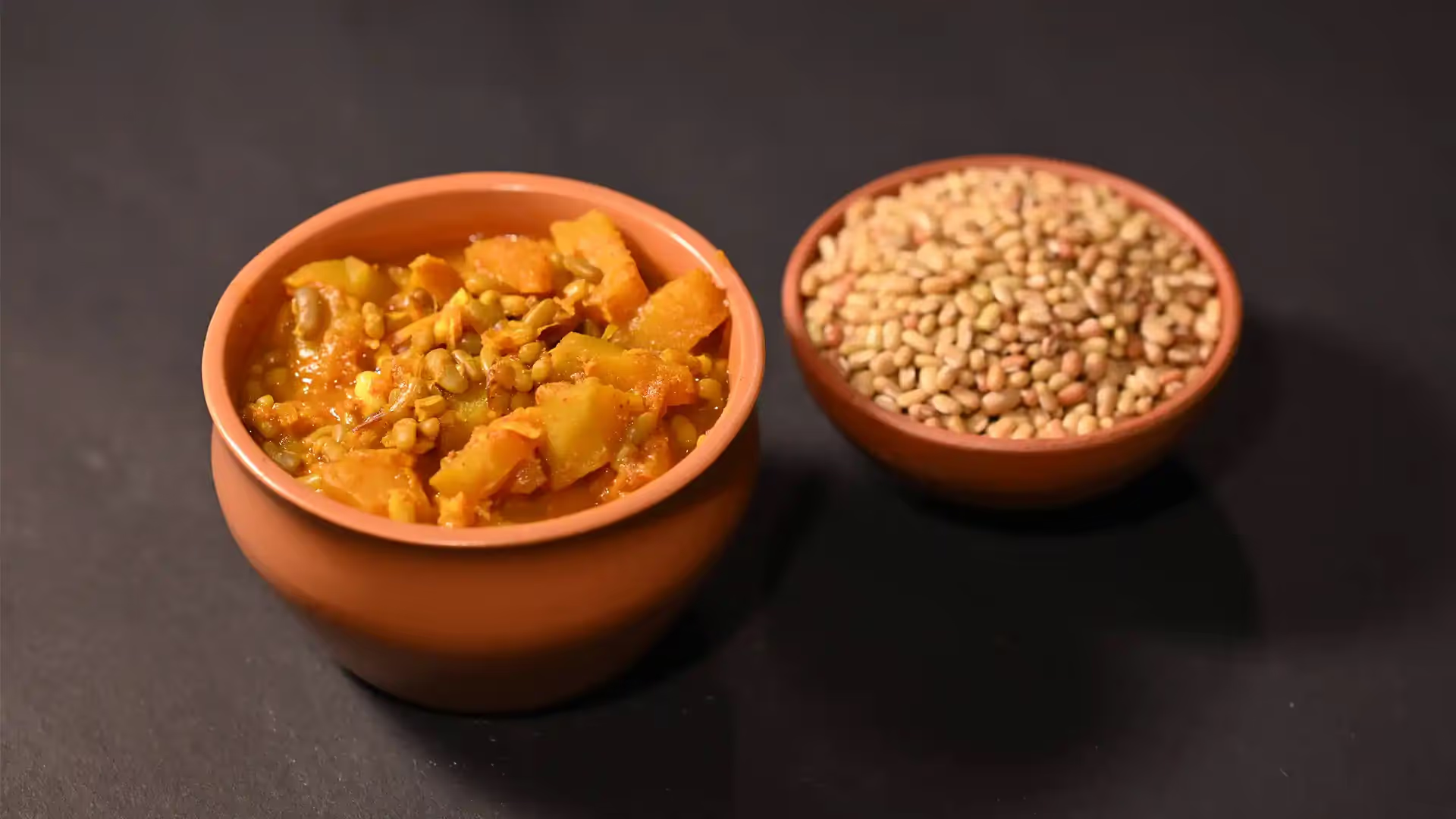
{{quiz}}
Explore other topics
References






.avif)
